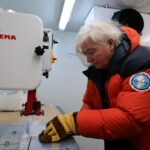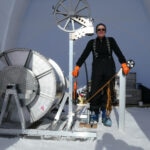The BBVA Foundation awards researchers who discovered the link between greenhouse gases and rising global temperatures enclosed within the polar ice
The BBVA Foundation Frontiers of Knowledge Award in the Climate Change category has gone to five European scientists for their analysis of Antarctic and Greenland ice samples to prove the “fundamental coupling” between greenhouse gas concentrations and rising air temperatures across the planet over the past 800,000 years.

The research conducted by Dorthe Dahl-Jensen (University of Copenhagen), Jean Jouzel and Valérie Masson-Delmotte (Laboratoire des Sciences du Climat et de l’Environnement, Université Paris Saclay), and Jakob Schwander and Thomas Stocker (University of Bern) has demonstrated that records extracted from Earth’s oldest and thickest ice deposits “show that changes in atmospheric concentrations of greenhouse gases, including carbon dioxide and methane, are accompanied by systematic changes in ambient air temperature across the globe,” according to the jury of the sixteenth edition of the awards.
As it gradually accumulates, the snow that forms the polar ice captures the air around it,” explains Miquel Canals, Director of the Sustainable Blue Economy Chair at the University of Barcelona and a member of the awards panel. “This air gets trapped in bubbles within the ice. And these bubbles are like a book on the atmospheric conditions prevailing through time which we need to decipher to get to their composition and meaning.”
The five awardee scientists have, in effect, reconstructed this precious record of the Earth’s climate conserved in the polar ice. “This is fascinating and invaluable work,” Canals continues, “which provides us with a benchmark for the current status of global warming.”
Notably, the panel’s report highlights how the laureates have demonstrated that "over the past 800,000 years, “concentrations of greenhouse gases due to natural variability had never reached the current atmospheric levels.”
Their work has “shown that today’s greenhouse gas concentrations are definitively off the scale. So we are on uncharted ground, living an experiment whose result is a question mark. And the threat is to human life, not nature, which has always found ways to adapt,” adds Joan Grimalt Obrador, a researcher at the Institute of Environmental Assessment and Water Research (IDAEA) of the Spanish National Research Council (CSIC) and nominator of Thomas Stocker for this year's award.
Ice cores, a time machine for understanding climate change
Ice core analysis has been a landmark in climate science, providing conclusive evidence of the linkage between greenhouse gases and the Earth’s temperature. Back in the 1960s, there were already physics-based climate models showing that increased atmospheric concentrations of carbon dioxide would lead to higher temperatures.
What was missing was concrete data on the composition of the atmosphere through history that could validate this finding. Jean Jouzel’s analysis of an Antarctic ice core from the Vostok base, published in Nature in 1987, delivered that necessary confirmation: “The link between changes in greenhouse gases and temperature was really established thanks to that Vostok ice core,” recalls the award winner.

Jean Jouzel, BBVA Foundation Frontiers of Knowledge Award in the Climate Change.
Ten years after that Nature article, Valérie Masson-Delmotte elaborated on Jouzel’s work, extending his analysis to Greenland ice cores. Her conclusions matched those obtained by her compatriot at the opposite end of the planet.
“Ice cores are these amazing time machines, Masson-Delmotte enthuses. “What is really striking is that we are finding ever stronger evidence confirming the intuition from the late 1970s.” And these records also highlight the extent to which atmospheric greenhouse gas levels have rocketed as a consequence of human activity: “The ice core record, together with other sources of information, shows that human influence on the whole climate system is unequivocal,” says the awardee scientist.

Valérie Masson-Delmotte, BBVA Foundation Frontiers of Knowledge Award in the Climate Change.
Potentially irreversible changes if temperatures continue to rise
As well as modeling past climate with ice cores, Masson-Delmotte has combined this data with multiple other aspects of climate science to predict what the Antarctic will look like in 2070 under different warming scenarios. “We show that if global warming holds at levels close to present day, major changes could be avoided for the region, while with larger degrees of warming, there would be potentially irreversible changes.”
One implication of this warming would be a rise in sea level, which is already 20 centimeters higher than in 1900 and with the rate of increase accelerating since the 1990s. We are heading for a sea-level rise of 50 cm by 2100 if warming is contained at low levels, and of more than one meter in the event of very high greenhouse gas emissions,” Masson-Delmotte warns. “These rises will affect about one billion people by 2050, with multiple direct consequences for our coasts.”
Reconstructing the past to understand the Earth’s future climate
The contributions made by Danish scientist Dorthe Dahl-Jansen lie primarily in the reconstruction of past climate from the study of Greenland ice cores, as written up in a 1998 paper published in Science.
Dahl-Jansen’s research has revealed that greenhouse gas concentrations never reached the levels seen today. “Even though there have been previous warm periods, like we had 115,000 years ago, where the temperature was actually four degrees warmer, we never saw CO2 values higher than 300 parts per million, while the average today is 420 ppm. So it is us humans who have brought about these heightened values of CO2 that are driving up temperatures.”

Dorthe Dahl-Jensen, BBVA Foundation Frontiers of Knowledge Award in the Climate Change.
Dahl-Jansen also points out that, based on the results of her research on abrupt changes in past climate, there is a risk that the pouring of fresh water into the ocean, due to the ice melt, could disrupt the ocean currents that give Europe its relatively mild winters. “The Gulf Stream is important because it warms northern Europe, Denmark and Spain as well. And if it shuts down due to global warming, it will strongly impact climate in our countries, though ironically enough, it will cool the temperature.”
Technological innovation to trace climate history in the ice
None of this research would have been possible without the technology to obtain ice cores, and here Jakob Schwander has been a pioneer. He refers to himself as “passionate” about engineering and ice drilling techniques. An area in which he is recognized as a brilliant innovator, developing, improving and creating new devices to reach ever deeper layers of pristine ice. This, precisely, has been one of his main contributions.
Just over ten years ago, Schwander began work on what would become his signature innovation, the world’s smallest ice drill, with a diameter of just 2 cm. Known as the RADIX (Rapid Access Drill for Ice eXtraction), in 2021 it reached a depth of 320 meters (-55º) in the Antarctic ice, a task completed in a few short days. “It’s a completely new technique,” Schwander points out. “Many parts of the drill had to be redesigned to make them small enough.”
“My contribution has maybe been to serve as a springboard for further studies. When I started, I was practically on my own. And now there are hundreds of people working on the subject.”

Jakob Schwander, BBVA Foundation Frontiers of Knowledge Award in the Climate Change.
New models for a “unique knowledge” of our planet
Thomas Stocker, who worked with Schwander on the RADIX project, has subsequently measured concentrations of carbon dioxide trapped in the air bubbles of ice cores extending back 800,000 years.
Seeking to interpret the data found, he developed a number of climate models to understand climate changes and drew three main conclusions. “First of all, carbon dioxide concentrations today are 35% higher than at any time in the past 800,000 years. Second, warming is without precedent in at least the last 2,000 years. And third, we have learned from polar ice cores that there are instabilities in the climate system, abrupt changes that could actually happen again in the future due to the large perturbations that man is inflicting on the climate.”

Thomas Stocker, BBVA Foundation Frontiers of Knowledge Award in the Climate Change.
The researcher insists that an important part of these findings is that they draw on data from both Antarctica and Greenland, providing “unique knowledge” about the dynamics of the Earth system. Abrupt changes in past climate indicate that the coupled system of the atmosphere and ocean have “limited stability” to perturbations, with the ocean being an important element in communicating large-scale climate disruptions between the hemispheres. Stocker points out that this had first been hypothesized based on model simulations, but “could then be confirmed by the precise analysis of ice cores from Greenland and Antarctica.”